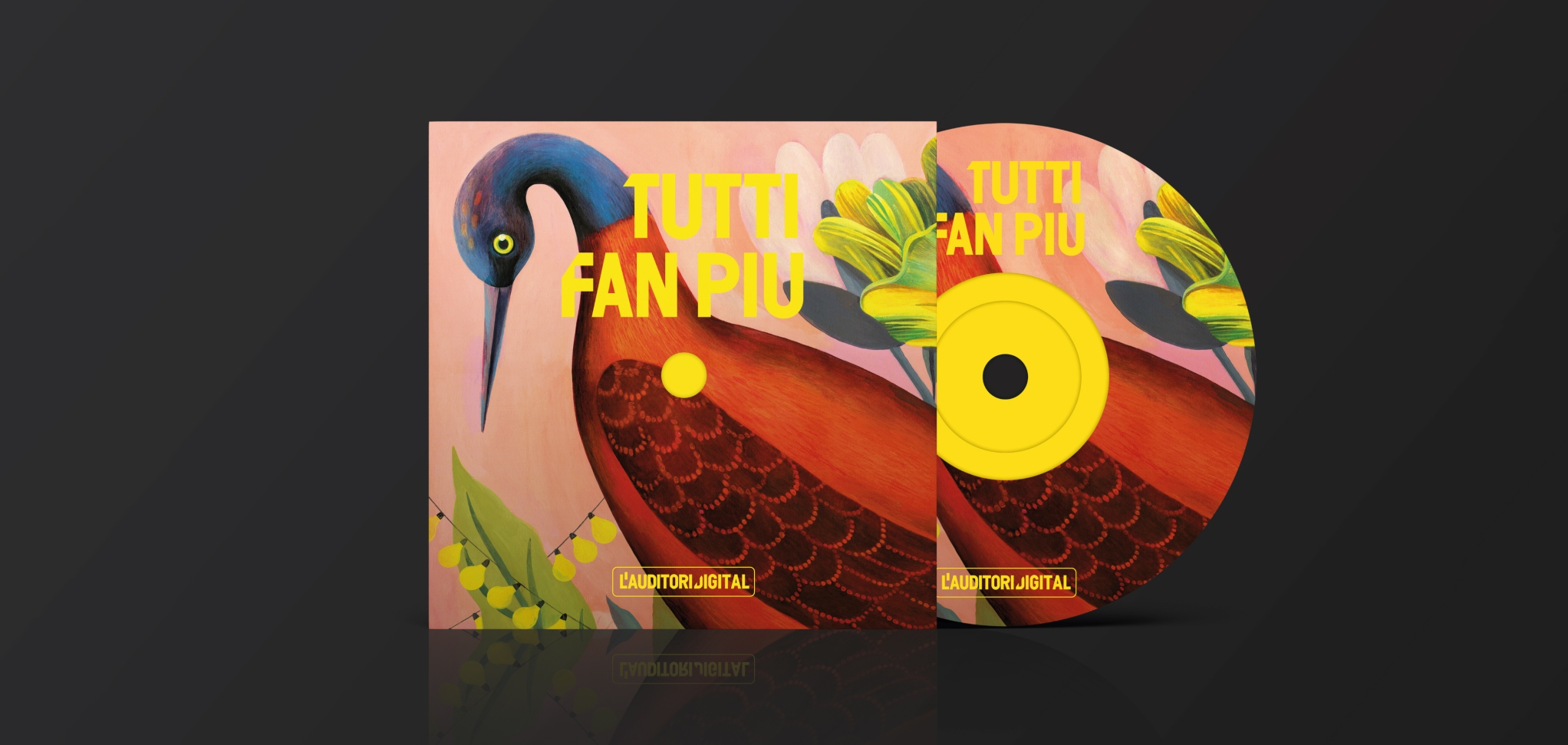
TUTTI FAN PIU
EDUCATIONAL PROJECT
Ducks, chickens, parrots, ostriches and penguins… birds that fly, swim, run and sing and dance to the music of very different eras and styles. Melodies that, like birds, travel and invite us to discover corners of the world.
LET’S LISTEN, LOOK… AND PLAY!
Tutti fan piu will make you dance, sing, listen and get excited with music from different places. From the hand of various birds and instruments you will take flight listening to magnificent musical arrangements, made by Marta Roma, and observing some tender and delicious illustrations drawn by Rebeca Luciani. We suggest that you follow and enjoy the games, activities and materials you will find in each song.
Selection and musical direction
Marta Roma
Scene direction
Montse Roig
Script and pedagogical proposals
Cristina González-Martín
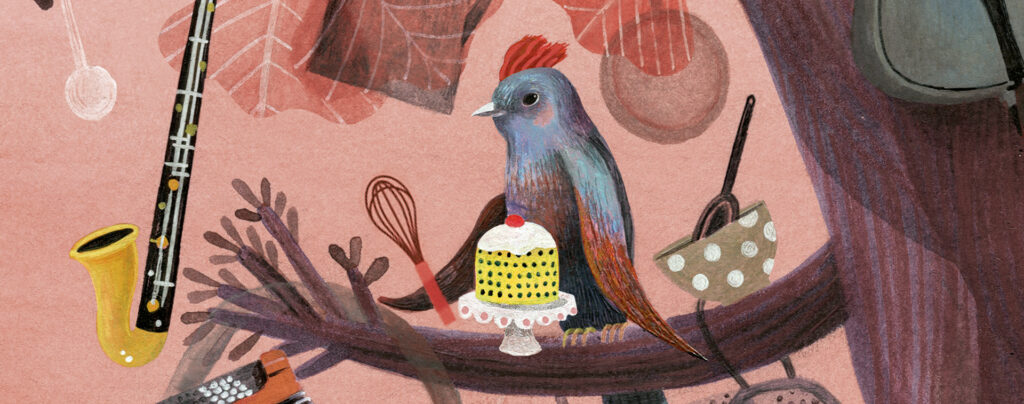
IMPROVISATION 1
the mandolin
TICO-TICO NO FUBÁ
(The sparrow and the corn) – Zequinha de Abreu. Arrangement by Marta Roma
Mandolin, bass clarinet, accordion, cello and percussion
GAMES, ACTIVITIES AND MATERIALS
This piece presents the main instruments that will accompany us throughout this CD. You will find them hanging on the tree in the illustration in order of appearance: percussion, mandolin, cello, bass clarinet and accordion. Play with them as you listen to them. In the illustration we can also see a sparrow, the Tico-Tico, with its kitchen utensils because it wants to eat a cake. Let yourself be carried away by the rhythm of this one I cry Brazilian, gather kitchen utensils and accompany it by pressing or making different sounds that may look good.
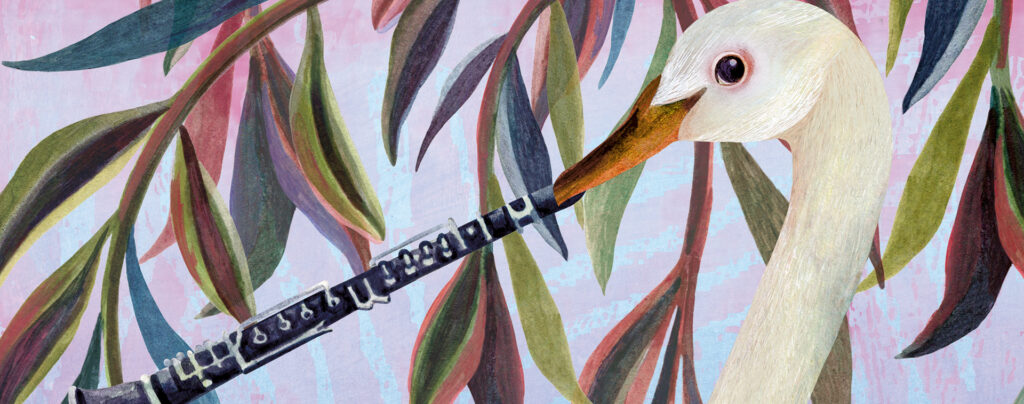
DANSE DES CYGNES
(Swan Dance) from Lac des cygnes. Op. 20, Act II no.13 – Pyotr Ilyich Tchaikovsky. Arrangement by Marta Roma
Clarinet, accordion and cello
GAMES, ACTIVITIES AND MATERIALS
This classic piece is part ofElswan lake, the first ballet composed by Tchaikovsky. In this arrangement, the accordion (carried by the black swan) and the clarinet (carried by the white swan) undertake a dialogue that we can continue to signal each instrument when it takes the lead. We can also move according to this ternary rhythm of the waltz, move around the space making long, tied movements following the main melody, or grab a black and a white handkerchief to represent the dialogue.
O PATO
(The Duck) – Jaime Silva, Neuza Teixeira
Brazilian banjo, cello, accordion, clarinet, percussion and voice
GAMES, ACTIVITIES AND MATERIALS
As we look at the illustration we can explain that this song is one bossa nova from Brazil which tells the story of a duck who, while singing a samba happily, a green-necked man asked him if he could be added to it. At the same time, a goose was delighted with the duo and went to look for a swan to propose to him to make a quartet; they began to sing near the pond, but it did not sound too good, and all four fell into the water. Listening to the song, as if you were the protagonists of the story, you can pass a microphone (or an object that symbolizes it) and sing in the language you want only when the onomatopoeia cuac-cuac appears (in Portuguese: who-who). Do you know how many times it appears? (answer: 33).
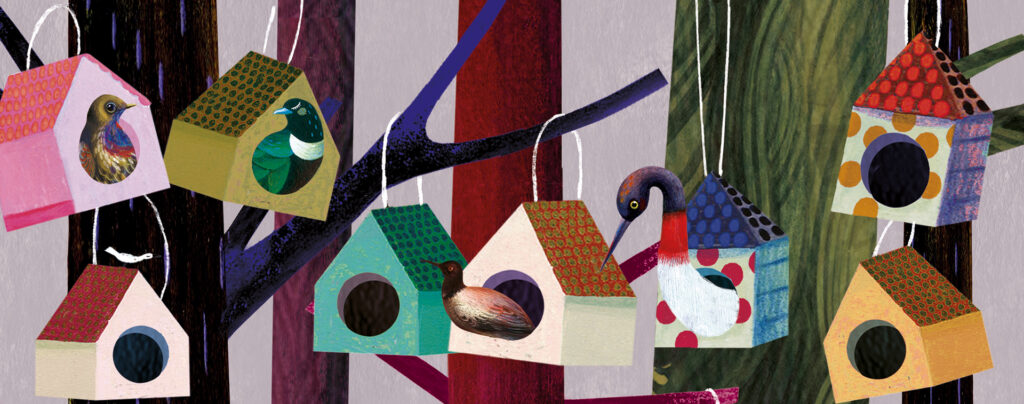
LE COUCOU AU FOND DES BOIS
(The cuckoo in the forest) from Le Carnaval des animaux – Camille Saint-Saëns. Arrangement by Marta Roma
Clarinet, accordion and cello
GAMES, ACTIVITIES AND MATERIALS
This is one of the classic pieces that make up the suite The carnival of animals, by the French composer Camille Saint-Saëns. The illustration helps us to follow the piece, which has a mysterious character: start with the house with the red dotted roof at the top right and go down, pointing to each house following the beat. When the cuckoo sounds (played by the clarinet), you must match the 2 joint houses where there are cuckoos. The route of houses follows a wave-shaped path from top to bottom and vice versa; do it 2 times and you will reach just halfway to the piece. From here, the music no longer follows this pattern. You can follow the houses randomly and, when the cuckoo sounds, point to the houses with a bird. Or, hide behind the CD book and stick your head out when the cuckoo sounds.
LE CYGNE
(The Swan) from Le Carnaval des animaux – Camille Saint-Säens. Arrangement by Marta Roma
Guitar, cello and bass clarinet
GAMES, ACTIVITIES AND MATERIALS
This is another piece ofThe carnival of animals. In this case, Saint-Saëns wants to describe a swan that swims elegantly, slowly through the water. In this arrangement, we can hear the beautiful sound of the cello making the melody while the guitar and then the bass clarinet accompany it softly. Get into the delicate, sweet character of the piece by grabbing a large handkerchief or cloth and playfully wrap and unwrap the little ones. Roll on the floor, wrap tenderly around each other, hug, tickle or massage with your handkerchief.
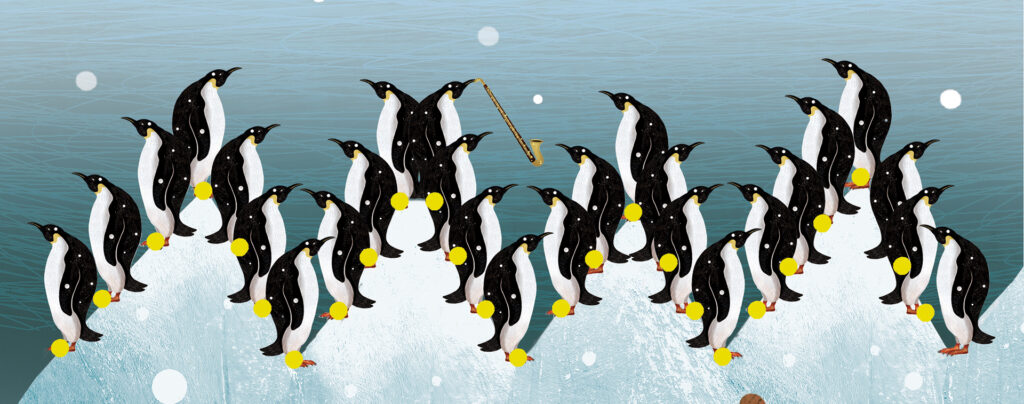
PENGUINS. THE TOY ROOM
Toni Vaquer
Bass clarinet, mandolin, accordion, cello and percussion
GAMES, ACTIVITIES AND MATERIALS
As we can see in the illustration, the accordion, percussion, cello and bass clarinet accompany a mandolin that, to the rhythm of funk, makes us move as if we were playful penguins in the middle of ice and snow. In this piece, the bass clarinet plays a stubbornness that you can keep pointing to the yellow dots of the penguins located on the icebergs. Start on the left. To compose the piece, Toni Vaquer was inspired by a room full of toys where the penguins walked free and played. You can play like them and mimic their walk (short steps and arms attached to your body) and kiss Eskimo with your nose. But be careful, because from time to time you will hear that the mandolin invites you to dust your tail or that, all of a sudden, all the instruments are silent and you have to stay still.
THE CUTTY WREN
English Folk. Arrangement by Marta Roma
Voices (choir), square tambourine
GAMES, ACTIVITIES AND MATERIALS
This folk song is one of the oldest protest songs recorded in England. It was used as a war cry by the peasants, who took the wren (snail bird) as a symbol, because despite being very small it has a great voice. The illustration shows us the idea of a collective that we also hear represented by this vocal group made up of 2 women and 3 men. As if we took one of the stars painted on it, we can build a cell phone with a ball of wool, hang it from a thread, pull the children to the ground and move it overhead following the character of the music.
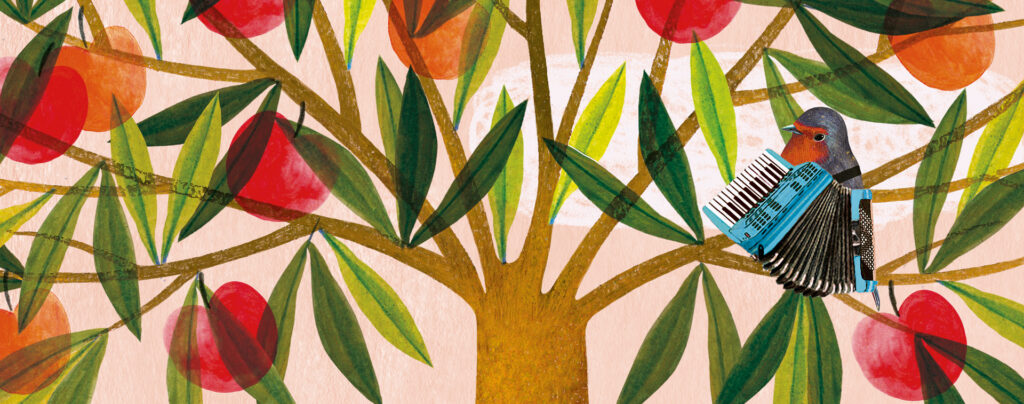
ALDAPEKO
(The apple tree branch) – Popular Basque. Arrangement by Edurne Arizu and Marta Roma
Accordion, voices, square tambourine
GAMES, ACTIVITIES AND MATERIALS
This Basque folk song tells the story of a little bird that sings from the tip of an apple tree’s branch. The bird sings xiru-liruli, xiru-liruli and, hearing it, we can accompany it by raising its arms and moving its hands. Older people can encourage you to follow the rhythmic pattern you will find in the illustration and which plays body percussion. You will notice that this piece has a very differentiated second part in which one growing it leads us to a debauchery that you can dance by bending down with your arms outstretched forward and moving your fingers and slowly getting up. Repeat this movement several times.
IMPROVISATION 2
the clarinet
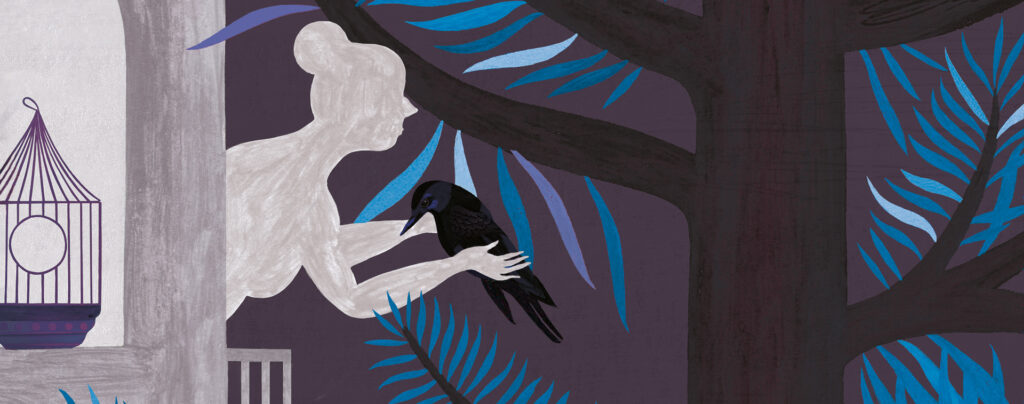
BLACKBIRD
The Beatles
Guitar, voice and percussion
GAMES, ACTIVITIES AND MATERIALS
This song leads us to the last light of night, when the blackbirds begin to sing. It is a very sweet piece, sung very delicately by female voices and exquisitely accompanied by guitar and percussion. Following the character of the music, you can turn off the lights and with a flashlight focus on the wall the silhouette of the children who show that they want every time the word appears blackbird.
BASIMBAYE
Traditional song from the Amazon in Peru. Adapted by Edurne Arizu
Voice and effects of birds
GAMES, ACTIVITIES AND MATERIALS
This short piece is a song awuaruna of the Peruvian Amazon. The effects of percussion place us in the middle of a lush jungle like the one we have drawn in the illustration. We will use the song to look for a magical bird that is very hard to find. They say it is the oldest bird that exists and that it is from the time of the dinosaurs. They also explain that he has three stomachs, no feathers, is plump and ugly. How do you imagine the oldest bird in the world? Draw it, and when you’re done, play hide and seek. You only have the length of the song to find it. If you haven’t found it, stay still until the song resumes and you can continue searching for it.
LES OQUES VAN DESCALCES
(The barefoot geese) Popularized children’s song. Arrangement by Eduardo Mercuri and Marta Roma
Cello, Brazilian banjo, percussion, whistle and voice
GAMES, ACTIVITIES AND MATERIALS
At the pace of joropo and farmer (styles of music typical of Colombia, Venezuela and Argentina), we are presented with the song “The geese go barefoot.” You can accompany the musicians by singing it. Look at the illustration and, like the goose, play at selling socks and shoes in exchange for kisses, hugs, tickles or songs… Take off your shoes and be ready to start the game: the musical introduction can help you grab your shoes and the socks you took off and leave them well prepared in a corner. Sing the song. In the musical interlude, you can hold hands and spin until the sung melody sounds again. Attention at the end of the piece: when the melody appears only whistled, it will be the signal to run to find the shoes and put them on before the piece is finished.
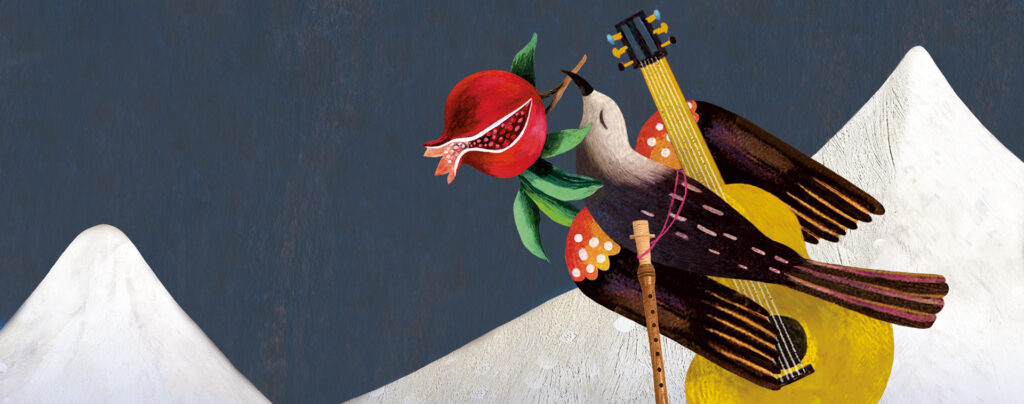
IMPROVISATION 3
the accordion
KRUNK / EL CANT DELS OCELLS
(The crane) – Soghomon Soghomonian “Komitas” / (Bird Song) Traditional Catalan. Arrangement by Marta Roma
Duduk, guitar, accordion, forest effects, birds and vocals
GAMES, ACTIVITIES AND MATERIALS
With airs from the Middle East we are presented with a piece performed by duduk (an Armenian instrument you have in the illustration), accompanied by guitar and percussion sound effects. The piece refers to the crane, a bird that symbolizes longing and nostalgia. We can also see the Ararat mountains and the fruit of the pomegranate, a symbol of the Armenian people. The landscape is wintery, when traditional carols are sung, such as “The song of the birds” (also considered a lullaby) that we can hear performed by the guitar and the duduk in the second part of this arrangement. Following the sweet and calm nature of the whole piece, children can put the toys to sleep, cover them because it is winter and it is cold, dance gently with them until they fall asleep, put them on gently and leave them in their place. place.
IMPROVISATION 4
percussion
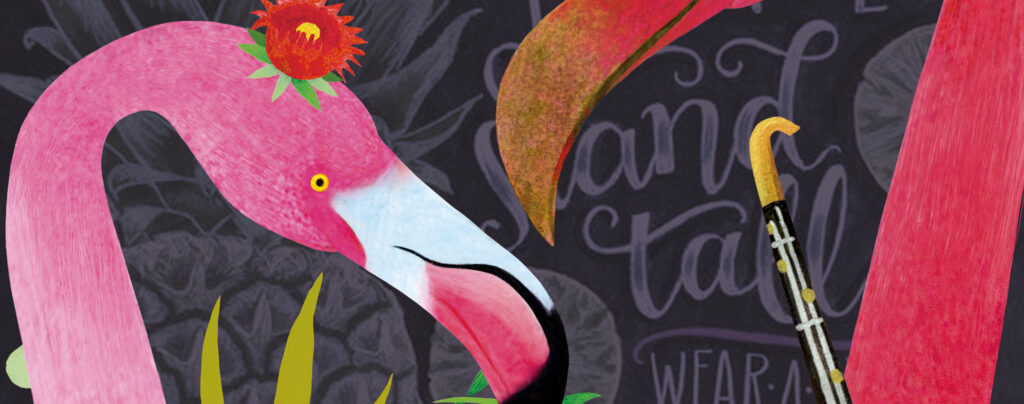
VOLIÈRE
(Cage for birds) from Le Carnaval des animaux – Camille Saint-Säens. Arrangement by Marta Roma
Clarinet, accordion, mandolin and cello
GAMES, ACTIVITIES AND MATERIALS
This is another piece ofThe carnival of animals. Saint Saëns describes an aviary with many birds. We can hear the clarinet representing the free flight of birds, while the cello, accordion and mandolin create a sound environment that evokes the movement of the air and the wings of birds. This piece is characterized by the ups and downs of the melody. With the older ones, you can follow them in the musicogram at the bottom of the illustration. You can also draw birds or make them out of paper and make them fly up and down following the melody.
IMPROVISATION 5
the cello
FLAMINGO
Ted Grouya
Bass clarinet, accordion, percussion, guitar, cello, trumpet with mute and voice
GAMES, ACTIVITIES AND MATERIALS
Written in the style of a bolero style that invites to dance, it represents the flamenco one, an elegant bird with a neck of very peculiar form that served as inspiration the composer, who wrote a melodic reason for 3 notes ( severe-acute-medium) that perfectly mimicked its shape. In the illustration you can see it represented by three flowers that follow the shape of the flamenco’s neck. This melodic motif appears many times throughout the piece and to recognize it you only have to listen to the first 3 notes of the audition, because they will surely remind you of the word fla-min-go (flamenco, in English), and saying it out loud will make it easier for you to recognize the reason. Listen to the piece and point to the illustration whenever this melodic motif appears. How many times have you heard it? (answer: 7). This melodic motif is played by different instruments in the following order: bass clarinet, voice imitating the trumpet with mute and accordion.
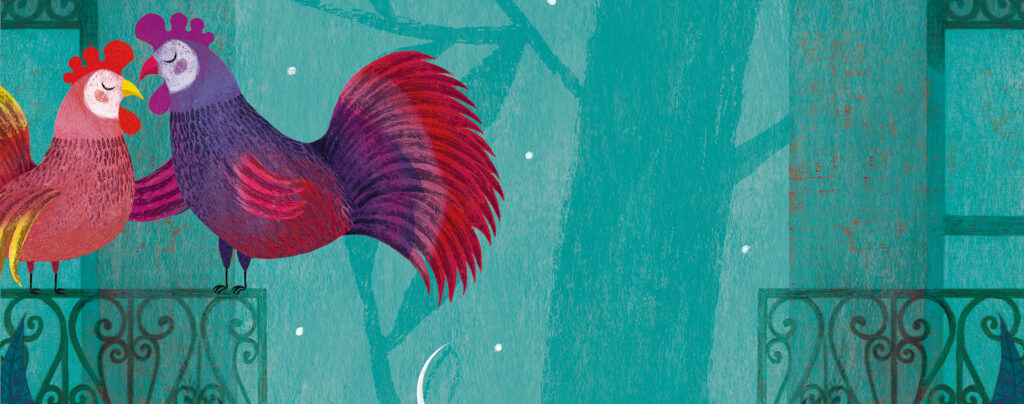
LA GALLINA ponicana
Cançó catalana popularitzada. Arranjament de Marta Roma
Violoncel i veu
JOCS, ACTIVITATS I MATERIALS
Amb un estil pop arribem a la cançó “La gallina ponicana”, una cantarella d’un joc infantil per pagar penyora documentada a finals del segle XIX. Mentre escolteu i canteu la cançó podeu fer el joc: asseguts a terra en una rotllana allarguem els peus al centre de la rodona. Hi ha una persona al mig que seguint la pulsació de la música va tocant els peus dels jugadors fins que la cançó diu “diu que amaguis aquest peu”. Seguint les instruccions es van amagant els peus i l’última persona amb el peu a dins de la rotllana és el que paga penyora, o la persona que ha sortit escollida per fer alguna cosa. També podeu aprofitar aquesta cançó per aprendre a comptar fins al número 10 amb els més petits. Amb els més grans, aprofiteu la segona part de la peça per aprendre l’embarbussament i reciteu-lo amb la cantant.
PAPAGAIO LOIRO
(El papagai bonic) – Popular portuguesa. Arranjament d’Eduardo Mercuri i Marta Roma
Acordió, violoncel, guitarra, percussió i veus
JOCS, ACTIVITATS I MATERIALS
Aquesta cançó popular portuguesa està escrita a ritme de forró (estil musical brasiler, que també és una dansa que es balla fent voltes en parella). Per als que us agrada ballar, deixeu-vos portar per la música i a moure l’esquelet! La cançó ens explica la història d’un lloro amb un bec daurat que ha de portar una carta d’amor. La melodia està interpretada per un duo femení i per l’acordió, i s’acompanya de la guitarra, el violoncel i la percussió que, entre d’altres, utilitza shakers (maraques). Podeu construir-ne posant cigrons o arròs en un pot buit amb tapa i acompanyar la música fent-los sonar.
TURKEY IN THE STRAW / CANÇÓ PER ADORMIR UN ESTRUÇ
(L’indiot a la palla) – Popular americana / Guillem Roma. Arranjament de Marta Roma
Acordió, violoncel, guitarra, percussió i veus
JOCS, ACTIVITATS I MATERIALS
Aquest arranjament combina dues cançons que parlen de dos ocells ben curiosos: el gall dindi i l’estruç. Amb un estil similar al country, en la primera part escoltem “Turkey in the Straw”, una de les cançons folks més icòniques del món rural estatunidenc. Tal com podeu observar a la il·lustració, el gall dindi és un animal amb una papada ben vermella i una cua oberta molt gran en forma de ventall. Per seguir aquesta primera part, podeu agafar un ventall, fer-lo servir de cua i moure’l mentre camineu seguint el ritme de la música. Jugueu a ventar-vos i a perseguir-vos. A la segona part de la peça, Guillem Roma ens presenta una cançó que volia ser una cançó de bressol i ha acabat sent una cançó amb aire de festa. Com que l’estruç es considera un ocell ràpid, la música s’accelera de tempo. El seu plomatge és tou i la cua sembla de cotó fluix, agafeu cotó fluix i mentre aneu ballant jugueu a tirar-ne pels aires i a fer, d’aquest final del CD, una festa ben volada!
CREDITS
Edurne Arizu accordion and voice Dídak Fernández percussion, whistle and voice Eduardo Mercuri mandolin, Brazilian banjo, guitars and voice Marta Roma cello, trumpet and voice Gener Salicrú clarinet, bass clarinet, duduk and voice
Music selection and direction: Marta Roma
Script and pedagogical proposals: Cristina González-Martín
Illustrations: Rebeca Luciani
Music production: Ferran Conangla, Enric Giné and Marta Roma
Recording, editing, mixing and mastering: Ferran Conangla and Enric Giné
Artistic coordination: Glòria Mas Chacori
Head of the Educational Service: Violeta Amargant
